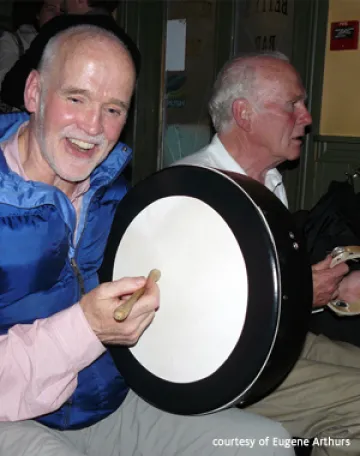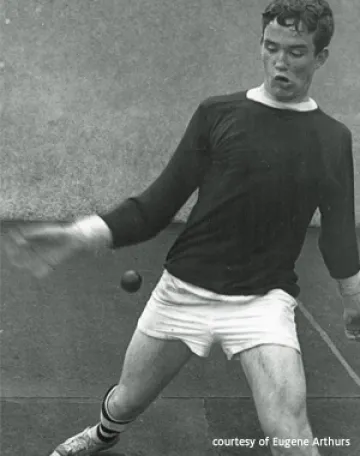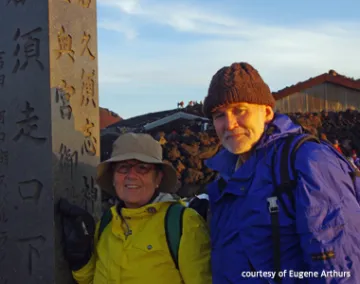Etendue: Eugene G. Arthurs

Welcome to Etendue, featuring interesting and accomplished individuals known for their leadership and contributions both with their careers and the College of Optical Sciences, in their own words. (For a similar view on the college’s best and brightest – our students – please check out Another Wavelength among our Students in the Spotlight.)
This month, we hear from Eugene G. Arthurs.
Where are you from?
I was born in a village called Keady in an area of Ireland a few miles from the political border and a few years before the return of what are called “the troubles.” The area was called “Bandit Country” in a 1976 BBC documentary. During my time in northern Ireland I had a comprehensive life education and developed a strong distaste for propaganda from the opposing factions. But that’s a story for another day.
My father was involved in local government, infrastructure development and the management of a large amateur sports organization. His office building, the “Town Hall” was demolished by a bomb, and the replacement office, a converted school, burned to the ground. Three of those who burned the school, former classmates of mine, died in the fire. My mother, the soul of patience, was a primary school teacher for more than forty years.

I must have been a precocious child as I started school at three and in short order the nuns had me on the stage in the classroom demonstrating the use of an abacus, the nearest we had to a computer at that stage. High school was ten miles away and I know now, I was inspired there by both excellent science and math teachers. A few years boarding at this boys-only school brought further education in survival. I played Gaelic football for the school and was the handball champion. I spent most of each summer in the Gaeltacht region on the stunning northwest coast of Ireland, a region where only Gaelic (Irish) was spoken and where we had class during the day and céilis and craic in the evenings. Dreaming in Gaelic meant the immersion experience worked.
My undergraduate and postgraduate days were at Queens University in Belfast. The educational system then meant specialization from the final two years of high school and into university. I took Chemistry, Physics, Applied Math and Pure Math. I veered towards physics as I found the chemistry labs too rote, and I confused the system by also taking Irish. I graduated first in 1969 with an honors B.Sc. degree, and with a Ph.D. under Professor Dan Bradley in 1972. It was the beauty of the light from an argon ion laser that made the decision for me to join his group. Dan was a remarkable and brilliant man, a latecomer to research after years as a high school teacher, but someone who had a truly global outlook, and who encouraged his students to believe, and supported their attendance at conferences. He had the largest laser group in Europe, in Belfast, and his academic progeny flourished. But by far the most important thing for me at university was my falling for and marrying my wild Irish rose.
I kept on playing sports, representing the university in handball, and playing Gaelic football. We persuaded the university to build brand new handball courts. At the opening I had a wonderful opportunity to play the current and past world champions, Pat Kirby, now a Tucson resident, and Joey Maher. Their modesty was a great lesson. The trashing I got and their brilliance suggested I’d better stick to laser physics.
Now I live in the well hydrated northwest of the US, in beautiful Bellingham, Washington.
Describe your professional career
I spent a few years as a postdoc, first at Queens and then at Imperial College, working on the generation and measurement of tunable ultrashort pulses, on non-linear processes and VUV lasers. 1ps was the short pulse record and Belfast held that record for a lot of ps. I joined Barr and Stroud in Glasgow, a wonderful 19th century organization, and spent time there developing lasers of all kinds, for industry and medicine. It was a wonderful learning experience. Any who’s who of photonics in Scotland has a strong Barr and Stroud component.

In 1980 I moved to US and started work with Quantronix, then Oriel, Cleveland Crystals and now SPIE.
Who are among your greatest influences in your professional career?
A long list indeed, starting with my extraordinary parents and wife. My math and science teachers at primary and high school led me to the intellectual joy of science. Dan Bradley was a great supervisor. His adventure in starting a company, ElectroPhotonics, and my modest involvement with it, was the start of a series of very enjoyable lessons in industry. I was privileged to work with Bob Daly, a laser pioneer and the CEO of Quantronix. Roger Gilbert the founder of Oriel and Lee Shizowa who brought me to Cleveland Crystals were truly the salt of the earth, life mentors. I know that the designers and people “on the shop floor” in manufacturing at Barr and Stroud and the other three companies I mentioned taught me a lot more than I ever taught them. The list of people who shaped me goes on quite a bit.
As its CEO, please share a single best SPIE experience.
Without a hint of blarney, being CEO of SPIE has been one great prolonged wonderful experience in itself. The belief of the staff in the field and what SPIE does is a constant inspiration. We work with a great membership base full of curious and ingenious people who want to change the world for the better. I think SPIE may have invented continuous improvement, kaizen, before it became so important in Japan. The number of students throughout the world lives were changed by SPIE for the better, is enormously gratifying. If you are to pin me down to one experience, then I might pick out the instantaneous positive response of SPIE leadership, to the opportunity to fund one of the FoTO scholarships at the College of Optical Sciences. In a way this action was a definition of SPIE.
What is your interest in the College of Optical Sciences?
I have spent my life in optics and photonics. I am drawn to excellence. I think that says it all.
Name one neat fact about you.
Well as my wife, Edna, and many others would quickly agree, “neat and I” do not go in the same library, never mind sentence. In these days of blether on migration, I like to recall that my paternal grandfather was born a U.S. citizen on a ship returning his parents from Pennsylvania to Ireland. My maternal grandfather died and is buried in New York. Like me, he was a migrant seeking new opportunity.

